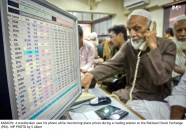Vendors ignore govt price lists
Wholesale markets follow official prices but retailers continue to hike consumer prices

The colourful piles of fresh fruits and vegetables at Islamabad's stalls may look inviting, but beneath the surface lies a well-practiced game of evasion and profiteering. From blaming rising transport costs to claiming high prices at the mandi, shopkeepers craft clever excuses to outsmart customers daily and dodge government price lists, hiking rates at will. These tactics not only squeeze the average shopper's wallet but also leave price control committees in a constant chase, turning regulation into an uphill battle.
Every morning, the city administration issues official rate lists to protect consumers from sudden price hikes. These lists cover essentials, from onions and tomatoes to mangoes and poultry, yet on the ground, they're often ignored or hidden from view.
At F-8, a middle-aged man haggled over tomato prices. The vendor insisted on Rs90 per kg, despite the government's list clearly displaying nearby the price fixed at Rs55. It might as well have been invisible.
This wasn't an isolated case. A quick survey of five stalls in the same market showed tomato prices ranging from Rs65 to Rs100, while the official rate remained Rs55. Mangoes listed at Rs200 per kg were being sold for as high as Rs450. Prices seemed to hinge more on customer awareness than any regulation.
Many shoppers, unaware of their rights, don't even know that these price lists exist.
"I honestly didn't know there was a daily rate list," said an area resident. "I just assumed prices changed by area." Others echoed similar confusion.
"It feels like every shop runs on its own rules," said a student from F-8 sector. "Nobody follows the list, and we don't know how or where to complain."
"We have to buy these things regardless," added a housewife from I-11. "No one takes these lists seriously. We're just at their mercy."
Low public awareness plays directly into vendors' hands
When questioned, shopkeepers offer a familiar rotation of excuses such as transport strikes, fuel prices, poor harvests, or inflated mandi rates. "Humain peechay se mehngi mil rahi hain," (our suppliers sold it to us at a higher rate) is the default line. While some reasons occasionally hold merit, they're often exaggerated to justify random markups, especially during high-demand days.
But Deputy Commissioner Islamabad Irfan Nawaz Memon while talking to APP, dismissed these justifications. In a conversation, he confirmed that Sabzi Mandis across the city were complying with official rates. "The shopkeepers' complaints are baseless," he said, urging people to verify by visiting the mandi themselves.
This disconnect raises a key question: if wholesale markets are following official prices, then why are retailers allowed to flout them so openly?
Legally, vendors may add a justified profit over wholesale rates, but not inflate prices arbitrarily. Yet enforcement of the Price Control and Prevention of Profiteering and Hoarding Act, 1977 remains weak.
Deception is common. Some vendors display the rate list as a formality; others hide it behind crates or omit MRPs from packaged goods. Many simply quote different prices to different customers based on how informed or unaware they seem.
Although price control officers are tasked with daily inspections, active monitoring usually spikes only around Ramzan and Eid. The rest of the year, overcharging continues with little pushback. Many shoppers remain unaware that they can file complaints through the Pakistan Citizen Portal, call their local assistant commissioner, or contact the DC Control Room at 051-9108084, a number printed daily on the rate list, but rarely noticed.
But fixing this isn't out of reach. Ensuring fair prices in markets isn't just about daily lists or occasional inspections. It requires a culture of compliance, stronger systems, and an informed public. When both vendors and buyers understand their roles within a transparent pricing structure, the space for confusion and manipulation naturally shrinks.
With consistent monitoring, smarter tools, and greater awareness, price stability can move from being a seasonal effort to a year-round standard. The use of simple tech solutions, like mobile apps, digital rate boards, and instant reporting can further bridge the gap between regulation and everyday practice. Similar to well-regulated economies, small steps, taken consistently, can lead to lasting improvements that benefit everyone involved.




















COMMENTS
Comments are moderated and generally will be posted if they are on-topic and not abusive.
For more information, please see our Comments FAQ